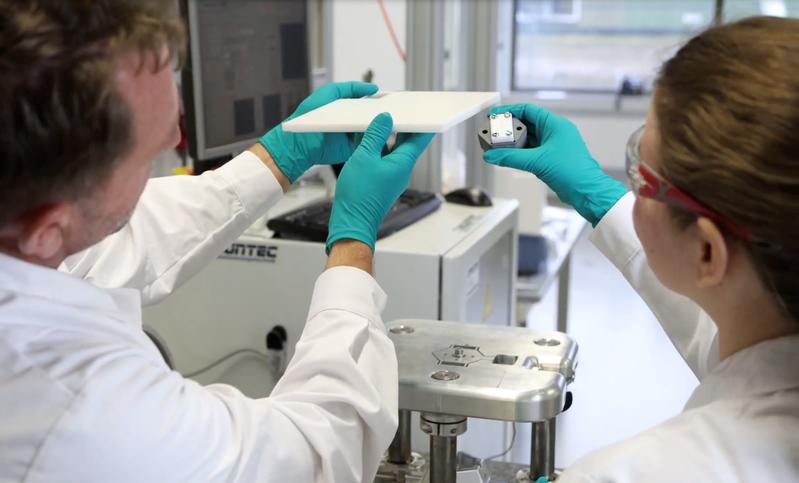Fraunhofer IWM and Glice AG develop synthetic ice with gliding properties similar to real ice
Climate change, snowmelt, and rising energy costs are putting pressure on ice rink operators. Skating on plastic sheets promises an economical and sustainable alternative. In a research project Glice AG from Lucerne, Switzerland and Fraunhofer IWM in Freiburg have now succeeded to develop synthetic ice with gliding properties that are in no way inferior to those of frozen water. The materials science research into the contact mechanisms, including the resulting material specifications necessary for enabling skating on plastic and the further development of the formula and manufacturing process for plastic ice sheets ultimately led to the breakthrough.
Many ingredients are needed for the perfect skating experience on an ice rink: the ability to start skating from a standing position, glideability for fun, a minimum of friction for pirouettes and braking, and hardness for the feeling of skating on ice. All these factors had to be made calculable and coordinated in a research and development project conducted by Glice AG, a leading company for synthetic ice technologies, together with Fraunhofer IWM in Freiburg in order to develop a steel-plastic sliding contact model.
"The first moment is particularly critical when ice skating. High initial resistance hinders the skater's safe start to gliding," explains project manager Prof. Dr. Matthias Scherge from the Fraunhofer Institute for Mechanics of Materials IWM. Therefore, the research initially focused on the first few seconds of gliding. In addition to the frictional forces, the depth of immersion of the blade was also investigated — a parameter that is crucial for assessing gliding behavior. "Only when the blade 'plows' with as little resistance as possible does the light and floating gliding sensation set in," adds the head of the Tribology business unit at Fraunhofer IWM.
In order to systematically elucidate the interaction between skate blades and artificial ice, Fraunhofer IWM has developed and constructed a special ice gliding simulator. This is used to simulate the start-stop and gliding situations between different skate blades and synthetic ice variants on a laboratory scale as well as to record the acting forces and other material characteristics.
Material and load combinations were systematically compared and evaluated with regard to friction and sliding mechanisms. Based on the measured values for friction and abrasion, a tribological model was developed, from which recommendations for promising formulations were derived. The scientific and technological challenge was to create a mechanically extremely durable surface that looks appealingly white and at the same time offers ultra-low resistance to the sliding of the skate blade.
After numerous optimizations in the material composition, the adaptation of the cleaning processes for the artificial ice surface, and the introduction of special conditioning procedures, a quality was achieved that is equivalent to gliding on frozen water. Laboratory results show friction coefficients of around 0.035 — values that are even slightly lower than those of frozen ice at low sliding speeds. By way of comparison: with a friction coefficient of 1, sliding is impossible; at 0.5, it feels as if sand has been sprinkled on the surface. Only below 0.1 does sliding become possible — and at 0.05, the fun begins.
The gliding effect is based on a combination of materials consisting of an ultra-stable base made of refined polyethylene and a highly mobile surface layer whose polymer chains offer little resistance to the blade. The skate blades also contribute to the success, of course — suitable grinding techniques further improve the result.
"From the skater's point of view, the gliding experience is what counts. From the ice rink operator's point of view, durability and sustainability are also important, of course. The panels have a service life of 10 years. After that, the reverse side can be used for another 10 years. Neither water nor coolant is required to operate such a rink," explains Viktor Meier, CEO of Glice AG.
The high tribological requirements that the developed polyethylene meets also make it interesting for applications in mechanical engineering, such as in slide rails, bearings, seals, and gears. It could also replace fluorinated polymers and thus help to avoid PFAS.
Wissenschaftlicher Ansprechpartner:
Prof. Dr. Matthias Scherge l Phone +49 172 6886852 | matthias.scherge@iwm.fraunhofer.de
Ähnliche Pressemitteilungen im idw



